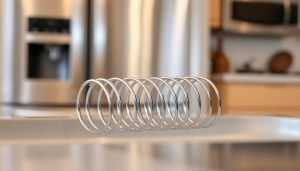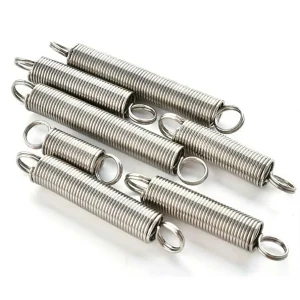A spring is an elastic mechanical element that stores and releases energy and is widely used in a variety of mechanical and electronic devices. The process of making springs is complex and varied, with specific steps including material selection, molding, heat treatment, and surface treatment.
What materials are used to make springs?
Springs are usually made from high-strength and high-elasticity materials, primarily including:
| Material Type | Common Materials | Characteristics | Applications |
|---|---|---|---|
| Carbon Steel | 70 Steel, 65Mn Steel | High strength, good elasticity, low cost | General springs, mechanical equipment |
| Alloy Steel | Chrome Vanadium Steel, Chrome Silicon Steel | Excellent performance under high temperature and stress | High-performance springs, automotive industry |
| Stainless Steel | 302, 304 Stainless Steel | Excellent corrosion resistance, good toughness | Food processing equipment, medical devices |
| Non-ferrous Metals | Phosphor Bronze, Beryllium Copper | Good electrical conductivity, corrosion resistance, fatigue resistance | Electronic components, precision instruments |
| Titanium Alloys | TC4, Ti6Al4V | High strength, low density, corrosion resistance, high-temperature resistance | Aerospace, medical equipment |
| Nickel Alloys | Inconel 718, Monel 400 | High temperature resistance, corrosion resistance, excellent oxidation resistance | High-temperature environments, chemical equipment |
| Plastics | Polypropylene, PTFE | Chemical resistance, lightweight, good insulation properties | Light-load springs, chemical and electronic applications |
| Composite Materials | Carbon Fiber Composites | High strength, lightweight, fatigue resistance, corrosion resistance | High-tech equipment, sports gear |
| Custom Materials | Richconn Custom Materials | Tailored to specific needs, meeting special performance requirements | Special purposes, high-precision equipment |
How does metal become spring?
The performance of the spring is ultimately determined by a number of critical processes in the process of converting metal into springs, including material selection, forming, and heat treatment.
1. Material Selection: Depending on the requirements of the spring application, the right metal is selected. Carbon steel, stainless steel, copper alloys, and titanium alloys are among the materials frequently used for springs. These materials resist corrosion, wear, and elasticity well.
2. Wire preparation: The chosen metal is formed into the necessary diameter of wire. This can be accomplished by using techniques like rolling or stretching the wire to guarantee its uniformity and quality of surface.
3. Forming: Either hot or cold forming is used to shape the metal wire into the shape of the spring. Cold-coiled springs: At room temperature, metal wires are coiled into a spiral or other configuration. Ideal for wire with a smaller diameter and less deflection. Hot Coiled Springs: ideal for larger diameter wires and greater deflection, these springs are made of metal that has been heated to a specific temperature and then coiled.
4. Application of Heat
Springs need to be heat treated after they are formed in order to enhance their stability and mechanical qualities. Common heat treatment procedures include quenching and tempering, which give springs the necessary hardness and toughness by quickly chilling (quenching) and then heating (tempering); aging treatment: to further increase the strength and flexibility of some alloy materials, they are treated for a set amount of time and at a specific temperature.
5. Application of surface coating
Surface treatment is typically given to springs to increase their fatigue life and resistance to corrosion.
Electroplating: To increase the spring’s resistance to corrosion, a layer of metal, such as nickel or galvanized, is plated on its surface.
Spraying: applying a layer of paint, powder coating, or another protective coating to the spring’s surface.
Polishing: Use mechanical or chemical polishing to enhance the spring’s surface quality and stress distribution.
6. Examining and evaluating
The produced springs undergo rigorous testing and inspection. Gauges are used to measure the springs’ hardness, fatigue life, and other performance indicators, as well as to determine whether their sizes and shapes meet design specifications.
FAQ
Which metal works best for producing springs?
The application criteria, such as strength, corrosion resistance, and fatigue life, determine which metal is appropriate for constructing springs. Stainless steel, high-carbon steel, and other alloy steels are examples of common materials. Materials like titanium and beryllium copper are frequently utilized for high-performance springs.
Which substance is the strongest when used to make springs?
Chrome-silicon and chrome-vanadium steels are examples of high-tensile steel alloys that are the strongest materials used to make springs. These materials are ideal for demanding applications because of their exceptional strength and endurance.
Can springs be made from stainless steel?
Indeed, springs can be fashioned from stainless steel. Stainless steel springs are very resistant to corrosion, which makes them perfect for applications where they come into contact with chemicals or moisture. The stainless steel grades 302, 316, and 17-7 PH are frequently utilized.
Is creating springs simple?
Specialized equipment and knowledge are needed to make springs. The procedure entails surface polishing, heat treatment, precise forming, and material selection. Simple or small-scale springs can be created with simple equipment, but industrial machinery and experience are usually needed to produce high-quality, dependable springs.
How are springs for extensions made?
The subsequent procedure is used to create extension springs:
Material Selection: Pick a wire made of a metal that has the right qualities, like stainless steel or carbon steel.
Wire Preparation: The wire is cleaned and trimmed to the proper length.
Forming: The wire is wound into a tight helix using a spring coiling machine. The device creates hooks or loops at the spring’s ends.
Heat Treatment: To increase the coiled spring’s flexibility and strength, heat treatment is applied.
Surface Treatment: To increase fatigue life and corrosion resistance, the spring is subjected to surface treatments like coating or plating.
Quality Control: To make sure the completed springs fulfill the necessary requirements, they are examined and tested.






